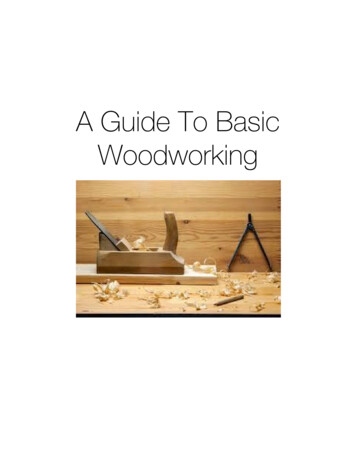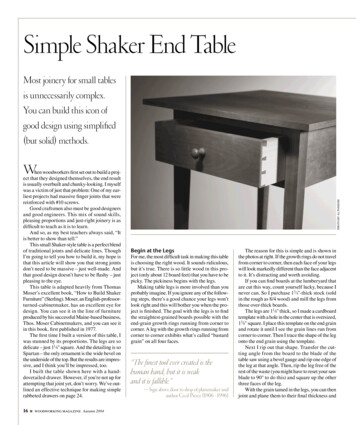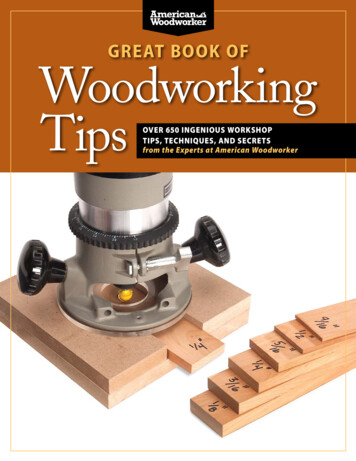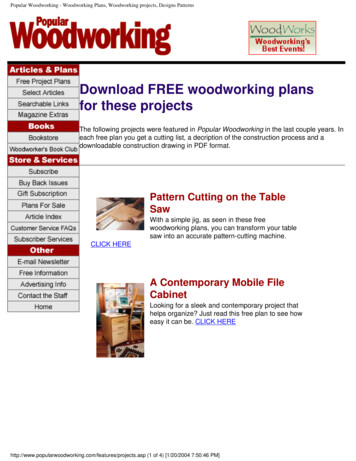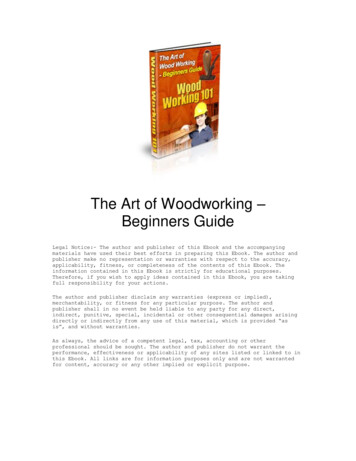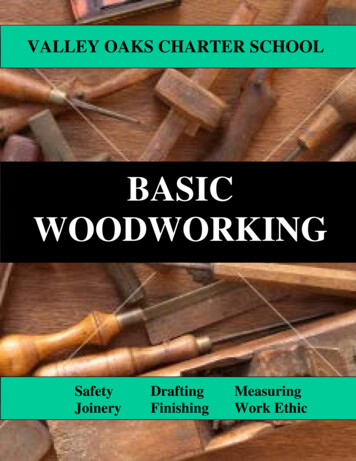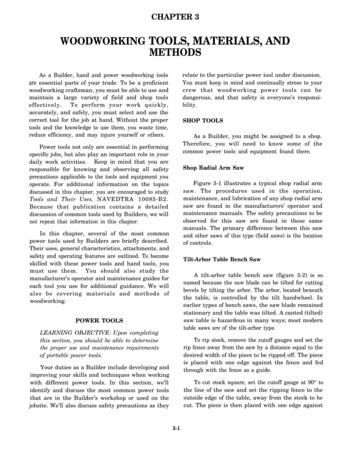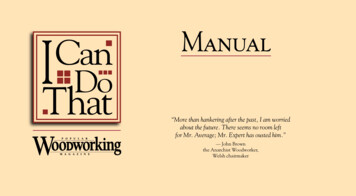
Transcription
Manual“More than hankering after the past, I am worriedabout the future. There seems no room leftfor Mr. Average; Mr. Expert has ousted him.”— John Brownthe Anarchist Woodworker,Welsh chairmaker
ContentsIntroduction Section 1: Toolschapter 1-1: Rules for Tools . . . . . . . . . . 2chapter 1-2: Measuring Tools. . . . . . . . . 4combination square,tape measurechapter 1-3: Saws. . . . . . . . . . . . . . . . . 10jigsaw, miter saw, circular sawchapter 1-4: Boring Tools. . . . . . . . . . . 28power drill, awlchapter 1-5: Finishing Tools . . . . . . . . . 32file, rasp, sander, block planechapter 1-6: Joinery Tools. . . . . . . . . . . 43biscuit joiner, pocket hole jigchapter 1-7: Fastening Tools. . . . . . . . . 53hammer, screwdriverchapter 1-8: Workholding . . . . . . . . . . 59Workmate, clampchapter 1-9: Routers & Router Bits. . . . 63Section 2: Techniqueschapter 2-1: Ripping . . . . . . . . . . . . . . . . 2chapter 2-2: Layout. . . . . . . . . . . . . . . . . 4egg crate shelf jointSection 3: Materials & Hardwarechapter 3-1: Selecting Lumber. . . . . . . . . 2chapter 3-2: Piano Hinge. . . . . . . . . . . . . 7
IntroductionWPopular WoodworkingMagazineicandothatextras.comhen you get started in woodworking thereare many paths to follow, forks in the road,dead-ends and shortcuts. It’s a journey that ourforebears would make with the help of a living,breathing guide: a master, a grandfather, a shopteacher.Sadly, the guides are fewer in number today.And so you are left with people like me tohelp. Like the making of meat byproducts, it’snot a pretty sight. Getting your woodworkinginstruction from books, magazines, televisionand the occasional class is a slow way to learn acomplex task. In fact, many woodworkers spend along time (years!) simply accumulating machinesand tools before they ever build a single pieceof furniture. And when they do begin to build,they inevitably discover that they actually needdifferent machines and tools to make what theyreally want to make.So they buy more tools and machines.I want you to know something important thatdoesn’t get said much: There is another way tobegin building furniture. You don’t need a tablesaw, a workbench or even a shop. You don’t needto spend 1,000 to build your first birdhouse. Youcan go to the home center in the morning andstart building something the same day.I’m not talking about building junk, either.The difference between a nice-looking set ofbookshelves and a rude assemblage of 2x4s isn’ta table saw. The difference is cleverness, sounddesign and just a wee bit of patience.To build nice furniture you need a handfulof decent tools that you won’t outgrow. Thisdocument will help you select the right tools thatstrike a balance between price and function. Youneed to use these tools correctly; we’ll show youhow to use them to build furniture (something
you rarely find in the instruction manual). Youneed a place to work; a driveway, garage or cornerof the basement will do nicely. You need goodmaterials; we’ll show you how to get everythingyou need from the local home center. And youneed plans and ideas for things to build that looknice and can be constructed with these tools,methods and materials.The plans are in a column featured in everyissue of Popular Woodworking magazine. Wecall the column “I Can Do That” because wewant readers to say that (out loud or in theirheads) when they open our magazine to thatpage. This document scrolling across yourscreen is the instruction manual for every singleproject featured in “I Can Do That.” It’s a livingdocument; as we introduce new techniques orideas, we’ll update this manual and load it to theweb site for you to retrieve.Eventually, we think you’ll outgrow thismanual as your skills improve. I bet you will wanta table saw someday. And a drill press. And asmoothing plane. When that day comes, however,Popular WoodworkingMagazineicandothatextras.comyou’ll also have a house full of well-proportioned,well-built projects under your belt. You will beready for those awesome tools, and the learningcurve will be mercifully shorter.If all this sounds like something that abunch of idealists cooked up at a corporatestrategy meeting, you’re wrong. Though I hadsome carpentry training from my father andgrandfather, I started building furniture on myback porch in Lexington, Ky., with a very similarset of tools. Probably the only major difference isthat I had a circular saw instead of a miter saw (Ididn’t know those existed yet). I built a lot of stuffwith my simple setup – some stuff we still havetoday and some stuff was long ago abandoned atthe curb or given away.So this, dear reader, is a valid path.My only regret in following it is that I wishthat I’d had this manual (or a master) to makethe journey easier.Christopher Schwarzchris.schwarz@fwmedia.comEditor, Popular Woodworking Magazine
1 Tools “The pioneers cleared the forests from Jamestownto the Mississippi with fewer tools than are storedin the modern garage.”— unknown, attributed toDwayne Laws
Rules for Toolschapter1.1I’m not an emotional guy. I don’t getnostalgic about high school, my firstcar or my first dog, Scampy. I don’t muchhug family members at holiday gatherings.But I do have the deepest respect andaffection for my tools. The care you givetools will gush readily into the things youbuild with them. None of the tools in thefollowing kit are disposable; if you takegood care of them, they will be aroundfor many years of service.Stop Rust Popular WoodworkingMagazineicandothatextras.comHere are some basic tips for caring for alltools. Don’t you dare let them rust. Rustspreads like a cancer in ferrous materials(iron and steel) and can make yourmeasuring and cutting tools difficult touse. There are a lot of products out thereto prevent and remove rust, but the bestthing going cannot be found on the shelf:a small can of vigilance.When you are done with a tool, wipedown the metal surfaces – especially thecutting surface – with a rag that has beensoaked with WD-40. Always keep therag nearby (mine is seven years old) andrenew it with a squirt of WD-40 when itgets dry. Wiping your tool down does twothings: First, it removes dust from the tool.Dust can carry salt. Salt attracts water.The combination of salt and moisturewill start breaking down your iron andsteel tools.Second, the WD-40 helps prevent rustby forming a thin protective barrier, albeitone that must be constantly renewed tobe effective. Other people will disparageWD-40 (I once did). Ignore them. Wetested all the rust preventative productson the market one spring weekend. Weapplied the products to a cast-iron plateand left the plate outside in the dewy grassfor a couple days. The area treated withWD-40 came out of the test looking thebest. WD-40 is cheap. It’s readily available.It won’t stain your work. Spray some on apiece of wood and watch what happens.Once it dries, there’s nothing to see.Learn to SeeAll of your tools require tweaking andmaintenance. They might work perfectlyright out of the box; they might not. Itall depends on who made the tool andwhat sort of day they were having whenyour tool came down the assembly line,whether the assembler was a robot or aperson.You need to learn to set up your toolsso they do what they were intended to do– cut square, bore straight holes, measureaccurately. Once you set them up, youneed to check on them every once in awhile. Trust, but verify. It’s a fact: Toolslose their settings after regular use.
chapter1.1In fact, one of the biggest challengesin woodworking is training your eye tosee the right things. You need to learn tosee if the cut is square. You need to see ifyour square is square. Have you ever heardthe old expression “tried and true?” It isan expression that applies to your tools aswell as your work. When you make a cutyou should test it to make sure it’s the cutyou wanted – this is called “trying” yourwork. If the cut is correct it is said to be“true.” Likewise with your tools, you musttry them to ensure they are cutting true.We’re going to show you how to test all ofyour tools (and joints) so they are true. It’snot hard, and it pays off big-time.Buying Quality Popular WoodworkingMagazineicandothatextras.comYou can spend a ridiculous sum on anytool – ridiculously huge and ridiculouslysmall. Jigsaws can cost 35 to 500. Awlscan cost 2 to 180. I wouldn’t recommendyou buy the tool on either extreme end ofthe spectrum. It would be easy for us tosay simply: “Buy the best you can afford.”But that’s a cop-out. If money is tight, youshouldn’t buy the 35 jigsaw. You shouldwait and save a bit more cash. If you’rea wealthy heiress, you shouldn’t buy the 180 scratch awl just because you canafford it (save your money for some realjewelry).What’s important is to buy tools thatdo what they are supposed to do. Toolsthat hold their settings. Tools that areeasy to maintain and adjust. Tools thatare reasonably durable. Tools that are safe.We are going to explain what is importantabout each tool, and what is not. Wemight not be able to offer brand-nameadvice or model numbers because thosechange from month to month and fromcity to city (no lie; ask me about that factover a beer sometime). But we can helpyou narrow your choices considerably.All of the tools on our list can bepurchased from a home center or ahardware store. There is no specialty stuffon the list to search the world for.
Measuring Tools – combination square, tape measurechapter 1.2 csquareombinationtape measureYou want to buy both of your measuringtools – a 12" combination square anda 16' tape measure – at the same timeso you can check the scale on one tomake sure it matches the other. Theyare unlikely to disagree, but if they do,you’ll be chasing your tail for a long timebefore you figure out what the problemis. To buy these tools, take a mechanicalpencil and scrap of wood with you to thestore that is at least 6" wide, 6" long andhas one straight edge.tool is worthless. There are ways to tweaka faulty square, but we don’t recommendthem. It’s not something you shouldhave to do. This is why you brought thewood and the pencil along with you –they will help you sort through the pileof combination squares to find the mostaccurate one in the bunch. Don’t beembarrassed to do this in the store; theyshould be embarrassed that you have todo this.12" Combination Square Popular WoodworkingMagazineicandothatextras.comThis is the tool that will lay out yourjoints and cuts, and check all your workto ensure your cuts are accurate. Thehome center should have a few differentbrands available with some variance inprice. Here’s what’s important:First, the square must be square. Theruler and head must meet at 90 or theIn general, we recommend a metal-bodiedcombination square. These are, usually, moredurable and accurate.
chapter 1.2 csquareombinationtape measure Popular WoodworkingMagazineicandothatextras.comFirst, take the ruler and press one edgeagainst the straight edge of your boardto confirm that the edge is straight.Generally you don’t want to see any lightpeeking out between the ruler and wood.If your wood is out of whack, wander overto the lumber section to look for an offcutto “borrow.” Usually there’s a barrel bythe panel saw or radial arm saw wherethey cut down big stock into small stockfor customers.With the square reassembled, press thehead of the combination square againstthe straight edge of the board and useyour fingers to hold the ruler down andsteady against the face of the board. Witha pencil, scribe a thin line along the edgeof the ruler. Make it as thin and consistentas possible. If the square moves or theline changes thickness, simply move thesquare and try again.Now flip the square over so the otherface of the ruler is flat against the faceof your board and hold the head of thesquare against the edge. Push the squareThe ruler from your combination square canconfirm if the edge of the board is straight.Usually off-the-rack lumber will have at least onedecent edge.Accuracy is important here. Keep the squareregistered securely against the wood asyou scribe the line. If anything feels like itshifted during scribing, make another line.Use a mechanical pencil to ensure your line isconsistent in width.
chapter 1.2 csquareombinationtape measure Popular WoodworkingMagazineicandothatextras.comup to your perfect line; this is called“showing the line to the square.” If theedge of the ruler is perfectly parallel toyour pencil line, you have found a squarethat is indeed square. Congratulations. Ifthe line is slightly off, try the test again.If it’s off in the same way, put the squareback for another sucker, er – shopper.Now look at the ruler itself. It mustbe readable. Look for fine dimensionmarks. Better-quality squares will havethem engraved in the metal rather thanprinted on. Ideally, you want the ruler tohave different scales on each edge. Thebest combination squares will have onescale in 8ths of an inch, another in 16ths,32nds and 64ths. You can get away withoutthe 64ths. The 32nds are helpful in mostcases. The 16ths are non-negotiable andnecessary.Remove the square from its headby loosening the nut below the ruler.The ruler should be easy to remove andreplace. You’ll be doing this quite a bit.Now tighten up the nut and make surethe ruler locks firmly in place. It shouldstay put when you tug on it.Check out the rest of the square. Isthere a bubble level in the head? Yes?No? It doesn’t much matter; it’s mostlyworthless in such a small tool. Is there aremovable scribe/scratch awl in the head?Again, pretty worthless in my book. I seemto lose mine in the first week and nevermiss it. It’s too small to use anyway.Treat your combination square like it isa holy relic. If it gets knocked to the floor,curse yourself and then test it immediatelyfor truth. If it’s out, get in your car andhead back to the hardware store. Throwaway the old head but keep the ruler – it’sstill useful. Never slide the ruler needlessl
Popular Woodworking Magazine icandothatextras.com MeaSurIng toolS – coMbInatIon Square, tape MeaSure Y ou want to buy both of your measuring tools – a 12" combination square and a 16' tape measure – at the same time so you can check the scale on one to make sure it matches the other. They are unlikely to disagree, but if they do, you’ll be chasing your tail for a long time before you .
